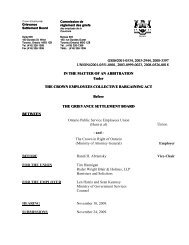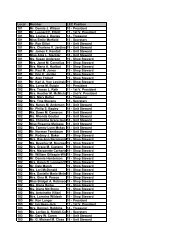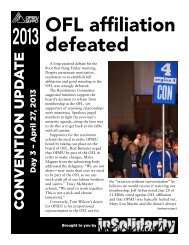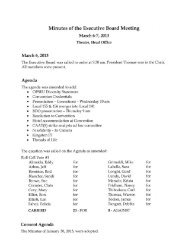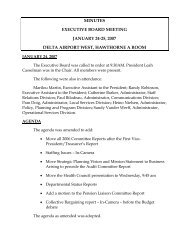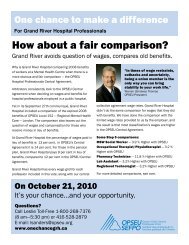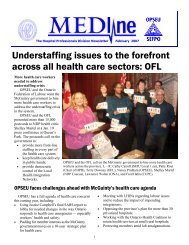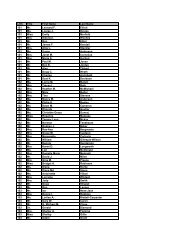Needlestick Safety and Prevention (NSAP) Checklist For ... - OPSEU
Needlestick Safety and Prevention (NSAP) Checklist For ... - OPSEU
Needlestick Safety and Prevention (NSAP) Checklist For ... - OPSEU
You also want an ePaper? Increase the reach of your titles
YUMPU automatically turns print PDFs into web optimized ePapers that Google loves.
<strong>Needlestick</strong> <strong>Safety</strong> <strong>and</strong> <strong>Prevention</strong> (<strong>NSAP</strong>) <strong>Checklist</strong><strong>For</strong> All Non-hospital Health Care WorkplacesUse this <strong>Needlestick</strong> <strong>Safety</strong> <strong>and</strong> <strong>Prevention</strong> (<strong>NSAP</strong>) <strong>Checklist</strong> to assess the extent towhich your employer has adopted safety sharps <strong>and</strong> implemented an exposure controlplan. If there is no Exposure Control Plan, or you answer “no” to any of the items in thischecklist, you should participate in this initiative <strong>and</strong> follow the Step-by-Step Process attached.NOTE: Regulation 474/07 requires hospital employers to replace hollow-bore needles withsafety-engineered needles or needleless devices. The Occupational Health <strong>and</strong> <strong>Safety</strong> Act(OHSA) S.25(2)(h) requires employers to take reasonable precautions to protect workers’ health<strong>and</strong> safety. Workers <strong>and</strong> their unions in all non-hospital workplaces must rely on OHSAS.25(2)(h) to convince their employers to take steps to protect them from dangerous sharps asthey are not covered by the new regulation.SHARPS SAFETY DEVICESSituations not covered by Regulation 474, but covered by S. 25 (2) (h) of the OHSABlood-Drawing:❏ Has your workplace implemented blood-drawing devices with integrated safety featuresdesigned to prevent percutaneous injuries?Examples of such devices include:• Shielded or self-blunting needles for vacuum tube phlebotomy.• Shielded, retracting or self-blunting butterfly-type needles, syringes with a cylindricalsheath that shields needles when injecting blood into tubes.• Blood gas syringes with a hinged needle shield that can be put in place over the needleusing a h<strong>and</strong>s-free technique.❏ Have all unnecessary needles been eliminated from use, including needles used for drawingblood from intravenous, arterial, <strong>and</strong> central lines? These devices can be replaced byneedleless or blunt cannula devices.❏ Does your workplace use automatically retracting finger/heelstick lancets in place of manuallancets or non-retracting spring-loaded lancets?❏ Has your workplace switched from glass to plastic micro-bore capillary tubes for measuringhematocrit (or to mylar-wrapped glass capillary tubes, or alternative methods of measuringhematocrit that do not require capillary tubes)? See Joint <strong>Safety</strong> Advisory issued by FDA,OSHA <strong>and</strong> CDC, in February 1999.
Joint Health Care Union SEMD Initiative/November 2007 Page 2<strong>Needlestick</strong> <strong>Safety</strong> <strong>and</strong> <strong>Prevention</strong> (<strong>NSAP</strong>) <strong>Checklist</strong> for Non-hospital Workplaces❏ Has your workplace replaced glass blood collection vacuum tubes with plastic tubes?❏ Have blood-drawing personnel been advised not to manually recap or remove needles fromblood-drawing devices?❏ Have blood-drawing personnel been advised not to reuse blood tube holders, which requiresmanipulation of a blood-filled needle?❏ Has the practice of injecting blood through a stopper into a vacuum tube using an exposedneedle been discontinued?Methods of drawing blood directly into vacuum tubes or other specimen containers shouldbe preferentially employed; alternatively, safety syringes with a cylindrical needle shieldlocked in place over the needle, which allow a vacuum tube to be inserted into the shieldduring blood injection, will reduce the risk of needlesticks <strong>and</strong> of blood splatter fromdislodged tube stoppers.Vascular Access:❏ Has your workplace implemented safety vascular access catheters that provide a protectiveshield for the stylet or blunt the stylet before or during its withdrawal from the patient?IV Infusion:❏ Has your workplace converted to needleless or recessed needle IV infusion systems?An FDA <strong>Safety</strong> Alert warned in 1992 of the dangers associated with “piggyback” or“intermittent IV” line connections. Since then, almost two-thirds of U.S. hospitals haveswitched to needleless or recessed needle systems. But beware: In some hospitals, bothsystems – needleless/recessed needle <strong>and</strong> needle-based – are sometimes provided side byside. Hospitals should eliminate needles used to access IV ports.Injection:❏ <strong>For</strong> syringes used for subcutaneous or intramuscular (IM) injections, has your workplaceconverted to devices that have integrated safety features, such as sliding sleeves, retractingneedles, or hinged caps, or to a needleless injection system?❏ Does your workplace specify that syringes should not be used for venous blood drawing,because of increased needlestick risk?❏ Has your workplace eliminated the inappropriate use of conventional or safety syringes foraccessing ports of needleless or recessed needle IV systems?❏ Does your workplace use safety-designed pre-filled syringes, where available, forvaccinations <strong>and</strong> other applications where pre-filled syringes are employed?
Joint Health Care Union SEMD Initiative/November 2007 Page 3<strong>Needlestick</strong> <strong>Safety</strong> <strong>and</strong> <strong>Prevention</strong> (<strong>NSAP</strong>) <strong>Checklist</strong> for Non-hospital WorkplacesSurgery:❏ Are blunt-tip suture needles, stapling devices, adhesive strips or tissue adhesives usedwhenever clinically feasible in order to reduce the use of sharp-tip suture needles?❏ Are scalpel blades with safety features used, such as round-tipped scalpel blades <strong>and</strong>retracting-blade <strong>and</strong> shielded-blade scalpels?❏ Are alternative cutting methods used when appropriate, such as blunt electrocauterydevices <strong>and</strong> laser devices?❏ Is manual tissue retraction avoided by using mechanical retraction devices?❏ Has all equipment that is unnecessarily sharp been eliminated?Example: Towel clips have been identified as a cause of injury in the operating room, yetblunt towel clips are available that do not cause injury <strong>and</strong> are adequate for securingsurgical towels <strong>and</strong> drapes. Other examples of devices that do not always need to havesharp points include surgical scissors, surgical wire <strong>and</strong> pick-ups.Additional Specialized Sharps Categories:NOTE: The devices listed below have safety-engineered equivalents <strong>and</strong> are covered by S. 25(2) (h) of the OHSA.Has your workplace implemented safety alternatives for specialized areas, such as:❏ Dialysis: fistula needles, syringes, blood drawing equipment, needle tubing access.❏ Blood banks: IV access devices.❏ Labs: sample transfer.Has your workplace implemented safety alternatives for specialized areas, such as:❏ Dialysis: retracting lancets, capillary tubes.❏ Blood banks: retracting lancets, capillary tubes.❏ Labs: slide preparation.<strong>For</strong> information on evaluating safety-engineered sharps devices, please refer to:www.tdict.org.
Joint Health Care Union SEMD Initiative/November 2007 Page 4<strong>Needlestick</strong> <strong>Safety</strong> <strong>and</strong> <strong>Prevention</strong> (<strong>NSAP</strong>) <strong>Checklist</strong> for Non-hospital WorkplacesEXPOSURE CONTROL PLANNOTE: An effective sharps safety program involves more than just replacing conventionalsharps devices with safety-engineered sharps. It is important to ensure that these additionalelements are also present. Compliance with OHSA Section 25 (2) (h) should require anexposure control plan <strong>and</strong>, therefore, should be included in your Joint Health <strong>and</strong> <strong>Safety</strong>Committee’s (JHSC) written recommendation to the employer.Does your workplace have a written exposure control plan?❏ Does the exposure control plan include a list of all jobs <strong>and</strong> tasks with potential for exposureto blood or bodily fluids?❏ Is it accessible to workers?❏ Is it reviewed <strong>and</strong> updated at least annually to document that safer medical devicesdesigned to eliminate or minimize occupational exposure have been evaluated <strong>and</strong>implemented?❏ Is it reviewed <strong>and</strong> updated at least annually to document that the employer has solicitedinput from non-managerial employees responsible for direct patient care in the identification,evaluation <strong>and</strong> selection of safety devices?❏ Is it updated annually to reflect changes in technology that eliminate or minimize exposureto blood or bodily fluids?SHARPS INJURY LOGNOTE: An effective sharps safety program involves more than just replacing conventionalsharps devices with safety-engineered sharps. It is important to ensure that these additionalelements are also present. Compliance with OHSA Section 25 (2) (h) should require anexposure control plan <strong>and</strong>, therefore, should be included in your JHSC’s writtenrecommendation to the employer.Does your workplace maintain a sharps injury log?❏ Does it include information on:• Type <strong>and</strong> br<strong>and</strong> of device involved in exposure incident?• Department or work area where exposure occurred?• An explanation of how exposure occurred?Other important information to track: Job classification of exposed workers, procedureinvolved, <strong>and</strong> whether the device causing the injury was a safety or conventional design. (Asurveillance system such as EPINet fulfills this requirement; for information on EPINet <strong>and</strong>for free forms <strong>and</strong> software, go to www.med.virginia.edu/epinet <strong>and</strong> click on “AboutEPINet.”)
Joint Health Care Union SEMD Initiative/November 2007 Page 5<strong>Needlestick</strong> <strong>Safety</strong> <strong>and</strong> <strong>Prevention</strong> (<strong>NSAP</strong>) <strong>Checklist</strong> for Non-hospital Workplaces❏ Does your workplace ensure injured employees’ confidentiality when recording <strong>and</strong>maintaining information in the sharps injury log?Training ProgramNOTE: An effective sharps safety program involves more than just replacing conventionalsharps devices with safety-engineered sharps. It is important to ensure that these additionalelements are also present. Compliance with OHSA Section 25 (2) (h) should require anexposure control plan <strong>and</strong>, therefore, should be included in your JHSC’s writtenrecommendation to the employer.❏ Has a training plan been developed to educate workers about the use of the new devices aswell as other program components?❏ Was the training program developed in consultation with the JHSC?❏ A comprehensive staff education program should include:• Legislation.• Goals/objectives of the program.• Explanation of blood-borne diseases, their modes of transmission, consequences ofinfection <strong>and</strong> treatment options.• Overview of injury demographics/statistic.• Labeling <strong>and</strong> identification of biohazardous material.• Policy regarding medical sharps <strong>and</strong> associated procedures.• Research/evidence for safety-engineered medical sharps.• Device-specific training.• Post-exposure procedures, including follow-up procedures.• Hepatitis B vaccination, its purpose, benefits, safety <strong>and</strong> availability.• Records of training.• An evaluation tool.





